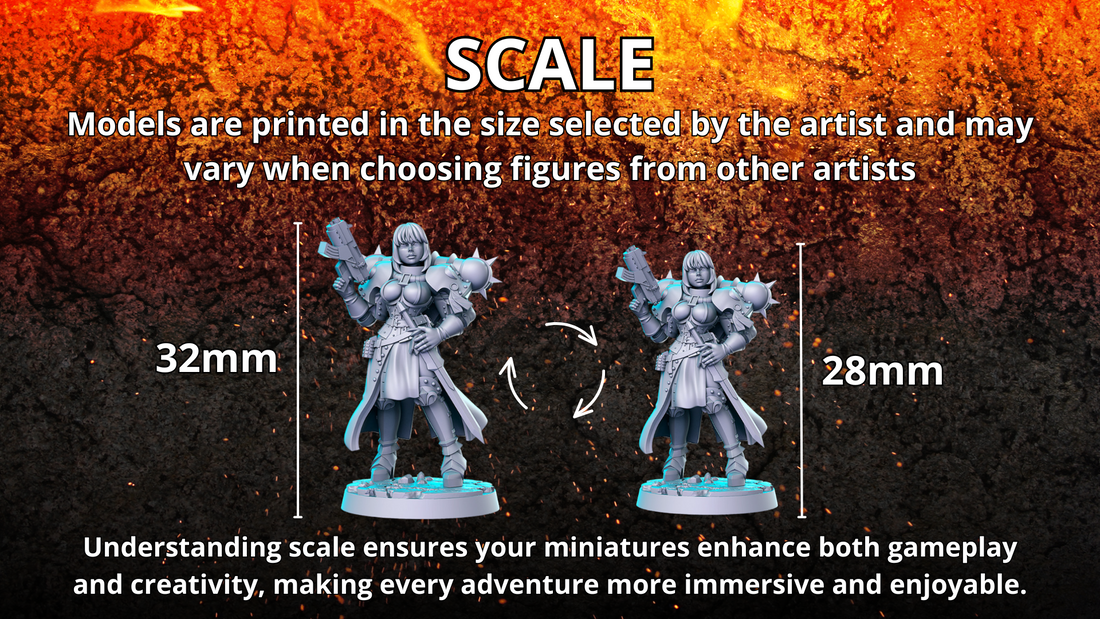
Understanding Scale in Dungeons & Dragons Miniatures: A Guide for Gamers and Collectors
Share
If you’re new to tabletop gaming or miniature collecting, one question you might have is: What is "scale," and how does it affect the miniatures I use for my games? In this article, we’ll demystify the concept of scale, focusing on its importance in games like Dungeons & Dragons (D&D), and explain why miniatures in the same scale can still vary depending on the artist or manufacturer. By the end, you'll be equipped to make informed choices when shopping for miniatures.
What Does "Scale" Mean in Miniatures?
In miniature gaming, "scale" refers to the proportional size of a miniature compared to its real-world counterpart. For example, a miniature in a 1:56 scale means that 1 inch on the miniature represents 56 inches on the actual object or character.
For fantasy miniatures like those used in D&D, scale is typically expressed in millimeters (mm). The most common scales for D&D miniatures are 28mm, 32mm, 38mm, and even 75mm.
- 28mm scale: This is considered a "classic" scale and is widely used for standard player characters or NPCs.
- 32mm scale: Slightly larger, offering more detail and visual impact, especially for prominent characters like heroes or villains.
- 38mm scale: Larger yet, often used for display pieces or to depict particularly imposing characters.
- 75mm scale: Primarily intended for collectors or painters, these are showcase pieces rather than practical game miniatures.
How Is Scale Measured?
Scale in miniatures is traditionally measured from the base of the miniature to the eyes, not the top of the head. This measurement standard originated to account for characters wearing hats or other tall accessories, ensuring consistency in proportional comparisons.
For example:
- A 28mm miniature stands 28mm tall when measured from the base to the eyes.
- A 32mm miniature will be proportionally taller, with more room for intricate sculpting.
Why Do Miniatures in the Same Scale Look Different?
Even within the same scale, miniatures can vary slightly in size and proportions. This variation occurs for several reasons:
-
Artistic Interpretation
Each sculptor or artist has their own style. Some prefer a "heroic" scale where hands, heads, and weapons are exaggerated for visual impact, while others lean toward realistic proportions. -
Manufacturing Tolerances
Different manufacturers use slightly different standards when producing miniatures, which can lead to small inconsistencies. -
Base Sizes and Posing
A miniature’s base or pose can affect its perceived size. For example, a crouching miniature in 32mm scale may appear smaller than a standing one, even if both are technically the same scale.
Why Does Scale Matter in D&D?
Choosing the right scale for your game is crucial for immersion and gameplay. Miniatures should match your gaming setup and terrain to maintain a consistent look. If your group primarily uses 28mm miniatures, a 38mm or 75mm miniature might feel out of place on the table (unless it's a boss character or a display piece). Conversely, mixing 32mm with 28mm is often manageable, as the difference is subtle.
Tips for Selecting Miniatures
- Know Your Setup: If your terrain and maps are designed for 28mm miniatures, stick to that scale for the best results.
- Check the Details: Read descriptions carefully when buying miniatures to confirm their scale.
- Embrace Variety: Remember that slight differences in size add personality and uniqueness to your collection.
- Ask Questions: If you’re unsure, feel free to contact us! We’re always happy to help.
Final Thoughts
Scale is an essential concept for any miniature collector or D&D enthusiast. Whether you’re painting, gaming, or simply collecting, understanding scale helps you choose miniatures that suit your needs and aesthetic preferences. While 28mm and 32mm are the most common scales we offer, don’t be afraid to explore larger sizes for special pieces or artistic projects.
Keep in mind that no two miniatures are ever identical, even within the same scale. These variations are part of what makes collecting and using miniatures so exciting. If you have any questions or need recommendations, we’re here to guide you every step of the way.
Happy gaming, and may your miniatures bring your adventures to life! 🎲
Feel free to share this article with anyone who’s curious about miniatures or just starting out in D&D. If you’re looking for high-quality miniatures in a variety of scales, check out our store!
